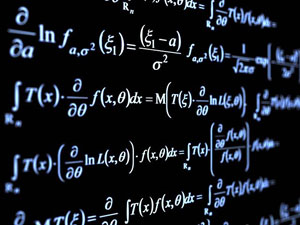Complex numbers arose in order to solve polynomial equations such as
or
which are not satisfied by real numbers. It’s assumed that a complex number has the form a + bi where a, b are real numbers and i, called imaginary unit, has the property that i2 = -1. Complex numbers are defined as follows.
- Addition.
- Subtraction.
- Multiplication.
- Division.
The ordinary rules of algebra has been used except that replaces i2 by -1 wherever it occurs. The commutative, associative and distributive laws also apply to complex numbers. It’s called a and b of a + bi the real and imaginary parts, respectively. Two complex numbers are equal if and only if their real and imaginary parts are respectively equal.
A complex number z = x + iy can be considered as a point P with coordinates (x, y) on a rectangular xy plane called in this case the complex plane or Argand diagram. If the line would be constructed from origin O to P and let ρ be the distance OP and φ the angle made by OP with the positive x axis, you could have from Figure

and could write the complex number in so-called polar form as

It’s often called that ρ the modulus or absolute value of of z and denote it by |z|. The angle φ is called the amplitude or argument of z abbreviated arg z. It could be also written
where
is called the conjugate of
.
If you write two complex numbers in polar form as

then
![\displaystyle z_1z_2 = \rho_1\rho_2[\cos(\phi_1 + \phi_2) + i\sin(\phi_1 + \phi_2)]\\\vspace{0.2 in} \frac{z_1}{z_2} = \frac{\rho_1}{\rho_2}[\cos(\phi_1 - \phi_2) + i\sin(\phi_1 - \phi_2)] \displaystyle z_1z_2 = \rho_1\rho_2[\cos(\phi_1 + \phi_2) + i\sin(\phi_1 + \phi_2)]\\\vspace{0.2 in} \frac{z_1}{z_2} = \frac{\rho_1}{\rho_2}[\cos(\phi_1 - \phi_2) + i\sin(\phi_1 - \phi_2)]](https://s0.wp.com/latex.php?latex=%5Cdisplaystyle+z_1z_2+%3D+%5Crho_1%5Crho_2%5B%5Ccos%28%5Cphi_1+%2B+%5Cphi_2%29+%2B+i%5Csin%28%5Cphi_1+%2B+%5Cphi_2%29%5D%5C%5C%5Cvspace%7B0.2+in%7D++%5Cfrac%7Bz_1%7D%7Bz_2%7D+%3D+%5Cfrac%7B%5Crho_1%7D%7B%5Crho_2%7D%5B%5Ccos%28%5Cphi_1+-+%5Cphi_2%29+%2B+i%5Csin%28%5Cphi_1+-+%5Cphi_2%29%5D&bg=T&fg=000000&s=0)
Also if n is any real number, you have
![\displaystyle z^n = [\rho(\cos\phi + i\sin\phi)]^n = \rho^n(\cos n\phi + i\sin n\phi) \displaystyle z^n = [\rho(\cos\phi + i\sin\phi)]^n = \rho^n(\cos n\phi + i\sin n\phi)](https://s0.wp.com/latex.php?latex=%5Cdisplaystyle+z%5En+%3D+%5B%5Crho%28%5Ccos%5Cphi+%2B+i%5Csin%5Cphi%29%5D%5En+%3D+%5Crho%5En%28%5Ccos+n%5Cphi+%2B+i%5Csin+n%5Cphi%29&bg=T&fg=000000&s=0)
which is often called De Moivre’s theorem. You can use this to determine roots of complex numbers. For example if n is a positive integer,
![\displaystyle z^{\frac{1}{n}} = [\rho(\cos\phi + i\sin\phi)]^\frac{1}{n} = \rho^{\frac{1}{n}}\left\{\cos\left(\frac{\phi + 2k\pi}{n}\right) + i\sin\left(\frac{\phi + 2k\pi}{n}\right)\right\}\\\vspace{0.2 in} \ \ k = 0,\ 1,\ 2,\ \cdots,\ n-1 \displaystyle z^{\frac{1}{n}} = [\rho(\cos\phi + i\sin\phi)]^\frac{1}{n} = \rho^{\frac{1}{n}}\left\{\cos\left(\frac{\phi + 2k\pi}{n}\right) + i\sin\left(\frac{\phi + 2k\pi}{n}\right)\right\}\\\vspace{0.2 in} \ \ k = 0,\ 1,\ 2,\ \cdots,\ n-1](https://s0.wp.com/latex.php?latex=%5Cdisplaystyle+z%5E%7B%5Cfrac%7B1%7D%7Bn%7D%7D+%3D+%5B%5Crho%28%5Ccos%5Cphi+%2B+i%5Csin%5Cphi%29%5D%5E%5Cfrac%7B1%7D%7Bn%7D+%3D+%5Crho%5E%7B%5Cfrac%7B1%7D%7Bn%7D%7D%5Cleft%5C%7B%5Ccos%5Cleft%28%5Cfrac%7B%5Cphi+%2B+2k%5Cpi%7D%7Bn%7D%5Cright%29+%2B+i%5Csin%5Cleft%28%5Cfrac%7B%5Cphi+%2B+2k%5Cpi%7D%7Bn%7D%5Cright%29%5Cright%5C%7D%5C%5C%5Cvspace%7B0.2+in%7D++%5C+%5C+k+%3D+0%2C%5C+1%2C%5C+2%2C%5C+%5Ccdots%2C%5C+n-1&bg=T&fg=000000&s=0)
Using the series for ex, sin x, cos x, you are led to define

which are called Euler’s formulas and which enable you to rewrite equations in terms of exponentials.
Complex numbers


